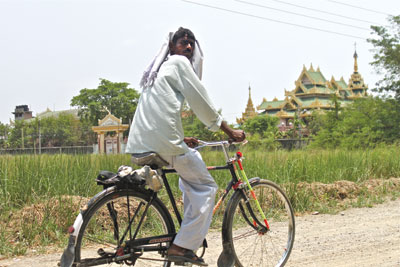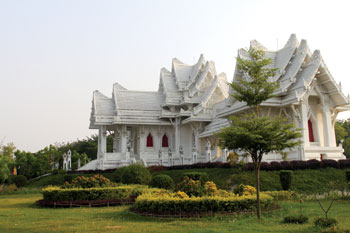 INDU NEPAL |
But suffering is as real for the people of Lumbini now as it was two millenia ago. Despite the area receiving nearly 780,000 domestic and international tourists each year, according to the Lumbini Development Trust, the locals at the periphery of the top cultural destination of the Tarai remain mired in poverty.
Lumbini, the birthplace of Gautam Buddha, is a study in contrasts. Inside the three-mile by one-mile compound are a cluster of newly built monasteries ranging in style from Thai wats to Manange stupas. This is a part of an ambitious plan outlined by Japanese architect Kenzo Tange in 1978 to transform Lumbini into an international pilgrimage and tourism centre. Forty-two monasteries and meditation centres were planned: 14 have been completed and 12 are currently under construction. The result is a mix between a giant construction site and Disneyland.
This massive endeavour seems to have brought meagre benefits to the locals who live in the periphery of the compound in mud huts, toiling on fields for landlords. The construction itself is 14 years behind schedule, and the villagers who were displaced at the time are increasingly frustrated. †
"They said there would be lots of employment opportunities," says Birendra Mishra, who was 10 years old when his father was relocated. "Now, the only jobs available are for gardeners and security guards."
In spite of impressive visitor numbers, Lumbini is a transit destination, say local business owners. Most visitors start their journey in India, which hosts three of the four pilgrimage spots declared sacred by the Buddha: Lumbini, his birthplace; Bodhgaya, where he obtained enlightenment; Sarnath, where he preached his first sermon; and Kushinagar, where he passed away.
"They rent cars in India, use their own guides, stop over for a few hours and return to hotels in India," says Lila Mani Sharma, who runs a lodge. "Getting them to extend their visit is our biggest challenge."
Despite occasional riots and online campaigns to stop India from allegedly claiming the Buddha was born in India, the battle to market the Buddhist circuit may already have been lost. †
"I have been to Bodhgaya and it seems like they spend a lot of money to preserve their sites," says Prahlad Yadav, president of the 18-member Local Tour Guide Association. "What we could do is to promote the Lumbini circuit as a package deal."
The well-known but less visited Lumbini circuit includes other sites associated with the Buddha including Tilaurakot, the ancient capital of Kapilbastu, and the Ashoka Pillar, which bears a stone document marking the birth of the Buddha.
Yadav and Sharma blame government apathy for the failure to harness the pilgrims' goodwill into a source of income for the locals. A proposal to convert Bhairahawa's airport into an international airport, which would allow Buddhist pilgrims to start their journey in Lumbini, was scrapped in favour of an airport in Bara.
The Lumbini Development Trust is in charge of implementing architect Tange's master plan and runs a few promotional activities. In order to celebrate Buddha Jayanti, which falls on 27 May this year, it is holding a debate competition among local students. It also hopes to honour senior monks and lamas in Lumbini but that will depend on the president's schedule.
Buddhists might tell you Tange's plan for Lumbini and other promotional campaigns will do little reduce the suffering of human life. If successful, however, such campaigns to attract tourists would certainly ease this suffering for the people of Lumbini.†
 |
How to get there: A number of commercial airlines fly daily to Bhairahawa airport. You can take a cab to Lumbini at a cost of about Rs 700, and buses leave every 15 minutes. An information brochure provided by the Lumbini Development Trust says bullock carts are also available, if you so fancy.
What to see: Mayadevi Temple, restored and reopened in 2003, contains the foundation of the original temple dating back to the third century BC. The Ashoka Pillar bears the first epigraphic evidence mentioning the birthplace of the Buddha. Tilaurakot is the ancient capital of Kapilbastu and a museum holds artifacts depicting life in the Shakya kingdom.
When to go: Best to avoid the summer heat.†
Where to stay: There are a couple of high-end and many budget lodging options in Lumbini, as well as in Bhairahawa. Monasteries in Lumbini offer accommodation for a donation, including meals.
READ ALSO:
Renewal: a time for change, Tsering Gellek
The Buddha's message, Publisher's Note
Running on Empty
Himalayan Art revisited
Hunger looms, Rubeena Mahato


